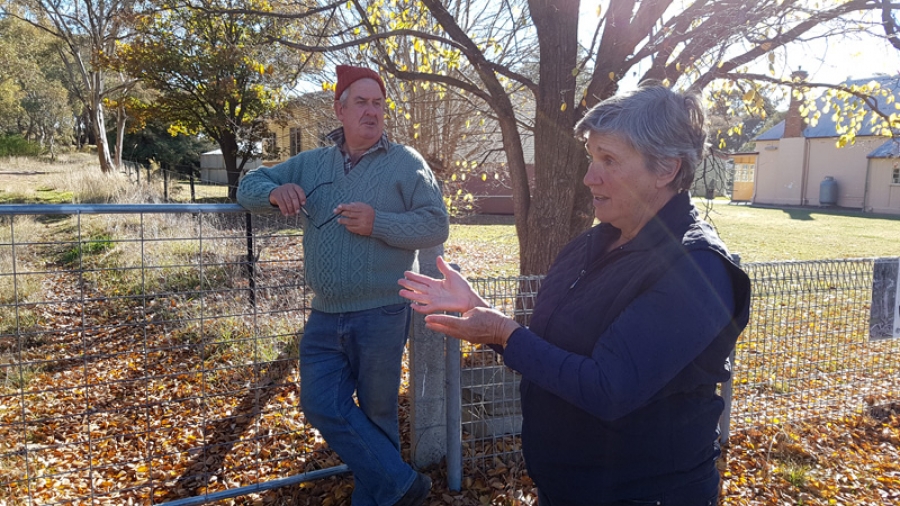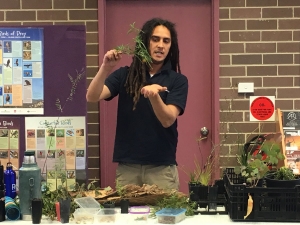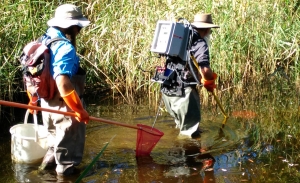Super User
Mates of Mundoonen
Mates of Mundoonen was originally a WIRES funded project to determine how the koala and the spotted quail-thrush are faring in the local Mundoonen Nature Reserve. The project is ongoing as funding becomes available.
Recently, koalas across the country were beleaguered by devastating bush fires and habitat destruction. Is our koala still with us locally? This project, led by local landcare groups from the Gunning and Yass districts, aims to find out – and to do all it can to help keep koalas here for the future.
Ngunnawal Bush Tucker School Holiday Activity
In the last week of school holidays, an enthusiastic group of children and a handful of parents gathered in the Gunning Library to learn about Ngunnawal bush tucker from Aaron Chatfield of Greening Australia.
Over tens of thousands of years, Indigenous people in this region have acquired an intimate knowledge of the plants, animals and landscapes that sustain their lives and culture. And as we discovered, children and adults alike in the Gunning district are eager to learn about how they can identify the native foods that grow on their farms and in their gardens.
Aaron displayed and talked us through a variety of Indigenous plants and tools, before offering samples of some delicious morsels. Roasted Bulbine and Chocolate Lily roots were popular, as was the Hardenbergia tea. The Mountain Pepper had a few people hopping on the spot! The children then helped to plant out a bush tucker garden between the library and the post office – keep your eye out as the plants grow bigger through the spring. Soap from Blackwood wattle leaves helped to clean dirty hands, and there were plenty of smiles as everyone left with a Chocolate Lily to plant in their own gardens.
An extra treat on the day was the presence of Aaron’s father, Greg Chatfield. Greg was involved in the production of the excellent book ‘Ngunnawal Plant Use’, two copies of which are now in Gunning Library.
Many thanks to the Gunning Library stuff who are unfailing friendly and helpful!
How truly wondrous are frogs!?!?
Anke Maria Hoefer from Frogwatch ACT had us all captivated with her interesting, entertaining and interactive presentation on frogs. Around 15 children and a handful of adults learned all about frogs’ lifecycle, everything frogs need to lead healthy lives, and what we can do to help look after them.
We heard how frogs use their eyes to ‘stamp’ on the food in their mouths; how males are the singers and females are the listeners in the frog world; how desert-dwelling frogs survive years of hibernation underground; how frogs are a bit partial to eating to one another; and plenty of other fascinating facts. Anke Maria was very impressed with the level of knowledge about frogs in the room, with many young participants offering up their insights too.
After filling up on all the interesting information, we got hands on – with some plastic pull-apart frog anatomy to put back together, and some great crafty projects. All the while a live Green and Golden Bell Frog watched on from the safety of its container.
There was lots of enthusiasm for more school holiday fun – feel free to pitch in your ideas for future events!
Latest news on Southern Pygmy Perch
Wondering what’s the latest news on Southern Pygmy Perch? As we’ve covered previously, Gunning District Landcare is working to conserve the endangered Southern Pygmy Perch and its habitat in our region. Southern Pygmy Perch is now only found in a very few locations in NSW, and we are very fortunate to be one of them. This means we have an opportunity (and responsibility!) to ensure that this local endangered fish does not go extinct.
Southern Pygmy Perch was originally native to large areas in the Lachlan, Murrumbidgee and Murray river catchments, but its distribution has been severely affected by the introduction of exotic fish, the spread of disease, and habitat modification and loss. Southern Pygmy Perch is also likely to be vulnerable to the effects of a warming climate.
In 2017, we commissioned fish experts Mark Lintermans and Luke Pearce to prepare a Local Action Plan to help guide local conservation efforts for Southern Pygmy Perch. Consistent with their recommendations, in March-April 2018 we organised for Mark Lintermans to survey fish in several local waterways. He was not only looking for Southern Pygmy Perch, but also for other fish (especially Redfin Perch) that are predators of Southern Pygmy Perch. This information is important when considering which sections of our creeks and rivers may be suitable for re-introduction attempts in the future. We will provide an update on the results of Mark’s monitoring work in the coming months.
We plan to continue monitoring local populations of Southern Pygmy Perch in the future and hope to involve community members to help with annual fish surveys — please get in touch if you are interested to be involved.
Also in March-April 2018, we engaged riparian expert Lori Gould to undertake habitat mapping along local waterways, and to assess nominated farm dams for their suitability as refuge sites for Southern Pygmy Perch. Many landholders in the Gunning region jumped at the chance to help conserve the endangered fish by nominating their damns as potential refuge sites. Lori has been kept busy speaking to landholders and visiting numerous properties. It is going to be very difficult to decide which dams will be selected to receive support in this round, but we are actively looking for more funding to expand this work into the future. So if you missed out this time, you will still be on the register and we will be able to consider you down the track.
If you are interested in improving the habitat qualities of your farm dams and riparian areas, you might be interested in the information below taken from our local action plan for Southern Pygmy Perch. There is also more detailed information available in this excellent brochure from the NSW Government.
What makes a suitable refuge dam for Southern Pygmy Perch?
Essential criteria:
- Permanent water, even during extreme droughts
- Abundance of aquatic plants – especially those that are emerged, submerged and floating
- No predatory or alien fish species present
- Good water quality
Desirable criteria
- No or limited stock access / dam fenced to exclude stock
- Abundant fringing vegetation, reeds, grass, shrubs and trees
- Dam not used as water supply
- Dam has a catchment in good condition. That is, good ground cover is maintained year round
- Additional habitat in the form of logs, rocks etc.
What makes a potential stream stocking location for Southern Pygmy Perch?
Essential criteria:
- Permanent water, even during extreme droughts
- Abundance of aquatic plants – especially those that are emerged, submerged and floating
- No predatory or alien fish species present
- Barriers to prevent alien fish invading
- Good water quality.
Desirable criteria
- No or limited stock access / stream fenced to exclude stock
- Abundant fringing vegetation, reeds, grass, shrubs and trees
- Low or no erosion
- Stream has a catchment in good condition. That is, good ground cover is maintained year round
- Low sediment loads
- Cooperative landholders and neighbours
- Few or no weeds, particularly blackberry and willows.
Southern Pygmy Perch Refuge Dams
In 2018, Gunning District Landcare called for people to nominate suitable farm dams as refuge sites for the threatened Southern Pygmy Perch. There are only three populations of this charismatic little fish left in the wild in NSW, and two of these populations are in the Gunning area!
Unfortunately, Southern Pygmy Perch is under severe threat from the voracious non-native Red Fin Perch. Farm dams are ideal as they are safe from predators and can be easily monitored.

Hunt for the Mundoonen Koala
In 2005 a local landcare member made the first confirmed sighting of a koala in the Mundoonen Nature Reserve. This was an occasion for great delight. Are koalas still there now? In September 2016 some GDL volunteers helped NPWS Rangers to undertake surveys to see if we could find evidence of their presence. Download the report
Gunning Village
We have begun work with Gunning Primary School to further develop local kids’ understanding and interaction with their local environment. Gunning District Landcare also has riparian plantings around Barbour Park and Meadow Creek, including the Bruce Bray Riparian Walk with interpretative signage. We hope to realise the potential offered by these sites, together with others such as the Golf Club, to be linked and enhanced to the benefit of the community and the local environment.
Dalton School Bush Block
Dalton Public School. It’s P&C Association, Gunning District Landcare and Greening Australia are protecting and enhancing the endangered Yellow Box Community that adjoins the school. Guided walks with interpretative signage will make this significant bush block and ideal Outdoor Education Centre.

Oolong Creek, Dalton
We have been working with the Dalton Community Association to remove woody weeds and replace them with native plants. During this work two local youngsters found two fish which they rightly believed to be a previously undiscovered remnant population of Southern Pygmy Perch – only the fourth population known! While this very small population is under great stress, it is a very hopeful and inspiring find for us. We will continue to maintain and improve this area.

Southern Pygmy Perch and Yellow Spotted Bell Frog Recovery Plan
Gunning District Landcare has been working with Luke Pearce from Department of Primary Industries Fisheries, and Dr Mark Lintermans, Associate Professor in Freshwater Fisheries ecology and management at University of Canberra, to develop the Southern Pygmy Perch Recovery Action Plan. Which will also benefit the Yellow Spotted Bell Frog. Both listed as endangered species.
Whilst both Southern Pygmy Perch and Yellow Spotted Bell Frog occur here in the Gunning area, populations are low and without help these species are unlikely to persist.
This local Recovery Action Plan will give us a clear action plan for the future to ensure our efforts are strategic and coordinated. The plan should be completed by Spring 2017.
Further supporting the maintenance and enhancement of suitable habitat for these species is to cease the practice of burning vegetation to clear waterways.
Please see the PDF - Managing Stream Vegetation








